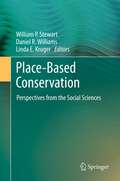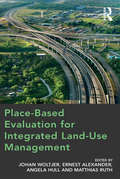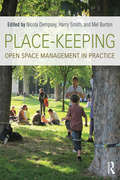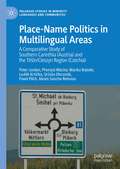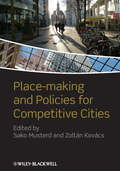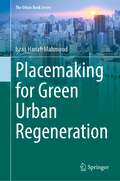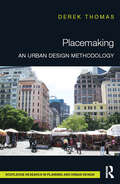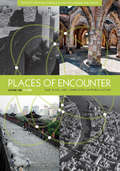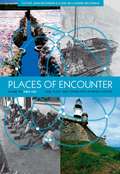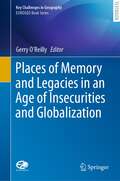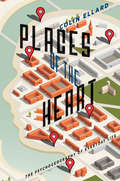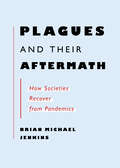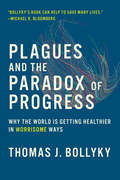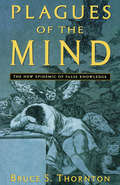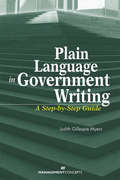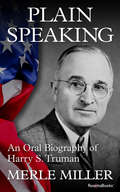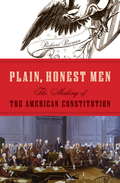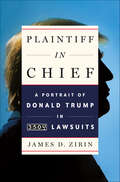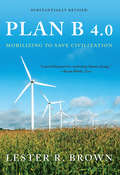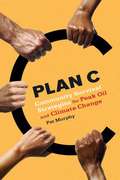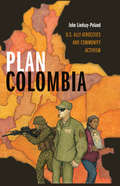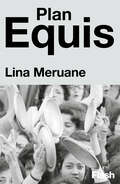- Table View
- List View
Place-Based Conservation
by Linda E. Kruger Suzette Dailey William P. StewartThe concept of "Place" has become prominent in natural resource management, as professionals increasingly recognize the importance of scale, place-specific meanings, local knowledge, and social-ecological dynamics. Place-Based Conservation: Perspectives from the Social Sciences offers a thorough examination of the topic, dividing its exploration into four broad areas. Place-Based Conservation provides a comprehensive resource for researchers and practitioners to help build the conceptual grounding necessary to understand and to effectively practice place-based conservation.
Place-Based Evaluation for Integrated Land-Use Management
by Matthias Ruth Johan Woltjer Ernest AlexanderIn recent years, there has been an increasing emphasis placed on local and regional integration in major planning projects and infrastructure development including roads, rail and waterways. This emphasis is not only on integrating various projects, but also integrating them with related issues such as housing, industry, environment and water. In other words, land-use planning and infrastructure management have become more spatially-oriented. This book brings together experts in the fields of spatial planning, land-use and infrastructure management to explore the emerging agenda of spatially-oriented integrated evaluation. It weaves together the latest theories, case studies, methods, policy and practice to examine and assess the values, impacts, benefits and the overall success in integrated land-use management. In doing so, the book clarifies the nature and roles of evaluation and puts forward guidance for future policy and practice.
Place-Keeping: Open Space Management in Practice
by Harry Smith Nicola Dempsey Mel BurtonPlace-Keeping presents the latest research and practice on place-keeping – that is, the long-term management of public and private open spaces – from around Europe and the rest of the world. There has long been a focus in urban landscape planning and urban design on the creation of high-quality public spaces, or place-making. This is supported by a growing body of research which shows how high-quality public spaces are economically and socially beneficial for local communities and contribute positively to residents’ quality of life and wellbeing. However, while large amounts of capital are spent on the creation of open spaces, little thought is given to, and insufficient resources made available for, the long-term maintenance and management of public spaces, or place-keeping. Without place-keeping, public spaces can fall into a downward spiral of disrepair where anti-social behaviour can emerge and residents may feel unsafe and choose to use other spaces. The economic and social costs of restoring such spaces can therefore be considerable where place-keeping does not occur. Place-Keeping also provides an accessible presentation of the outputs of a major European Union-funded project MP4: Making Places Profitable, Public and Private Open Spaces which further extends the knowledge and debate on long-term management of public and private spaces. It will be an invaluable resource for students, academics and practitioners seeking critical but practical guidance on the long-term management of public and private spaces in a range of contexts.
Place-Name Politics in Multilingual Areas: A Comparative Study of Southern Carinthia (Austria) and the Těšín/Cieszyn Region (Czechia) (Palgrave Studies in Minority Languages and Communities)
by Peter Jordan Přemysl Mácha Marika Balode Luděk Krtička Uršula Obrusník Pavel Pilch Alexis Sancho ReinosoThis book explores the role of place names in the formation and maintenance of individual and group identities in multilingual and multi-ethnic situations. Using examples from Austria and Czechia as case studies, the authors examine the power of place names through an interdisciplinary and multi-methods approach that draws from the fields of anthropology, geography, sociolinguistics and toponomastics. The book contextualises both places within their social and political histories, and probes recent debates in the social sciences relating to place names, identity and power. It will be of interest to scholars and students focusing on place names and naming practices, minority communities and languages, and linguistic landscapes.
Place-making and Policies for Competitive Cities
by Sako MusterdUrban policy makers are increasingly striving to strengthen the economic competitiveness of their cities. Currently, they do that mainly in the field of the creative knowledge economy - arts, media, entertainment, creative business services, architecture, publishing, design; and ICT, R&D, finance, and law. This book is about the policies that help to realise such objectives: policies driven by classic location theory, cluster policies, ‘creative class’ policies aimed at attracting talent, as well as policies that connect to pathways, place and personal networks. The experiences and policy strategies of 13 city-regions across Europe have been investigated: Amsterdam, Barcelona, Birmingham, Budapest, Dublin, Helsinki, Leipzig, Milan, Munich, Poznan, Riga, Sofia and Toulouse. All have different histories and roles: capital cities and secondary cities; cities with different economies and industries; port-based cities and land-locked cities. And all 13 have different cultural, political and welfare state traditions. Through this wide set of contexts, Place-making and Policies for Competitive Citiescontributes to the debate about the development of creative knowledge cities, their economic growth and competitiveness and advocates the development of context-sensitive tailored approaches. Chapter authors from the 13 European cities rigorously evaluate, reformulate and test assumptions behind old and new policies. This solidly-grounded and policy-focused study on the urban policy of place-making highlights practices for different contexts in managing knowledge-intensive cities and, by drawing on the varied experiences from across Europe, it establishes the state-of-the-art for both academic and policy debates in a fast-moving field.
Placemaking Fundamentals for the Built Environment
by Dominique Hes Cristina Hernandez-SantinThis book is for all those actively working in the built environment. It presents the latest theory and practice of engaging with stakeholders to co-design, develop and manage thriving places. It starts from the importance of integrating design of nature into practice built on a foundation of First Nations understanding of place. The art of engagement of community, government and the development industry is discussed with reference to case studies and best practice techniques. The book then focuses on the critical role placemaking has in supporting resilience and adaptability of communities and looks at issues of leadership and governance. Building on these steps for placemaking, the last parts of the book address economics, evaluation, digital and art based tools and approaches to support projects that aim to create an engaged, contributive, collaborative and active citizen.
Placemaking for Green Urban Regeneration (The Urban Book Series)
by Israa Hanafi MahmoudThis book investigates the dynamics and the role of green urban regeneration using nature-based solutions (NBS) in contributing to the cultural aspects of public spaces. In the first part of the book, insights on analytical methods, planning strategies and shared governance examples are given, as well as, an assessment tool, namely public space index (PSI), is given for successfully measuring sociability impact while using a placemaking approach to green urban regeneration processes. In the second part, the case study (Rose Kennedy Greenway of Boston, MA, USA) has been extensively researched during many years of observations and analysis which gives a realistic taste of the implementation of the proposed PSI. The book’s last part reflects on PSI to measure its adaptability and replicability in other contexts, whereas NBS are playing a major role in physical and spatial green urban regeneration in current cities contexts’.
Placemaking: An Urban Design Methodology
by Derek ThomasEnd-users provide the most valuable perspective and insights into how public social space should function. Much of the failure of urban settings can be related to over-structured urban environments which deterministically prescribe usage, constraining instead of enabling socio-spatial performance. Planning decisions by specialists should be made with the participation of the end-user to minimise uncertainty as far as possible, creating enabling environments. Placemaking: An Urban Design Methodology presents a methodology that evaluates the preferences of urban dwellers and synthesises these with the planning specialist’s expertise, better representing all views. Author Derek Thomas integrates the Sondheim Methodology with means to understanding cultural clues to create a matrix methodology that links planning primers with planning actions. A unique new tool for community planners, this book emphasises the importance of the community while taking into account the expertise of the planner in creating public spaces.
Places of Encounter
by Aran Mackinnon Elaine MackinnonPlaces of Encounter provides a place-based approach to world history, focusing on specific locations at critical moments when human history was transformed as a result of encounters--physical, political, cultural, intellectual, and religious. Original, contributed essays by leading academics in the field explore places from Hadar to Xi’an, Salvador to New York, and numerous other locations that have produced historical shockwaves and significant global impact throughout history. With a chronologically organized table of contents, each chapter dissects a particular moment in history, with personal commentary from each contributor, a narrative of the location’s historical significance at the time, and a section on significant global connections. Primary sources and discussion questions at the end of each chapter allow students a view into the lives of individuals of the time. Students will experience the narrative of historic individuals as well as modern scholars looking back over documentation to offer their own views of the past, providing students with the perfect opportunity to see how scholars form their own views about history. This text can be purchased as two volumes, providing a breadth of information for survey courses in world history.
Places of Encounter: Volume II
by Aran Mackinnon Elaine MackinnonPlaces of Encounter provides a place-based approach to world history, focusing on specific locations at critical moments when human history was transformed as a result of encounters--physical, political, cultural, intellectual, and religious. Original, contributed essays by leading academics in the field explore places from Hadar to Xi’an, Salvador to New York, and numerous other locations that have produced historical shockwaves and significant global impact throughout history. With a chronologically organized table of contents, each chapter dissects a particular moment in history, with personal commentary from each contributor, a narrative of the location’s historical significance at the time, and a section on significant global connections. Primary sources and discussion questions at the end of each chapter allow students a view into the lives of individuals of the time. Students will experience the narrative of historic individuals as well as modern scholars looking back over documentation to offer their own views of the past, providing students with the perfect opportunity to see how scholars form their own views about history. This text can be purchased as two volumes, providing a breadth of information for survey courses in world history.
Places of Memory and Legacies in an Age of Insecurities and Globalization (Key Challenges in Geography)
by Gerry O’ReillyIn this book, practitioners and students discover perspectives on landscape, place, heritage, memory, emotions and geopolitics intertwined in evolving citizenship and democratization debates. This volume shows how memorialization can contribute to wider inclusive interpretations of history, tourism and human rights promoted by the European Project. It's geographies of memories can foster cooperation as witnessed throughout Europe during the 2014-18 WWI commemorations. Due to new world orders, geopolitical reconfigurations and ideals that emerged after 1918, many countries ranging from the Baltic and Russia to the Balkans, Turkey and Greece, eastern and central Europe to Ireland are continuing with commemorations regarding their specific memories in the wider Europe. Shared memorial spaces can act in post conflict areas as sites of reconciliation; nonetheless `the peace' cannot be taken for granted with insecurities, globalization, and nationalisms in the USA and Russia; the UK's Brexit stress and populist movements in Western Europe, Visegrád and Balkan countries. Citizen-fatigue is reflected in socio-political malaise mirrored in France's Yellow Vest movement and elsewhere. Empathy with other peoples' places of memory can assist citizens learn from the past. Memory sites promoted by the EU, Council of Europe and UNESCO may tend to homogenize local memories; nevertheless, they act as vectors in memorialization, stimulating debate and re-evaluating narratives. This textbook combines geographical, inter-cultural and inter-disciplinary approaches and perspectives on spaces of memory by a range of authors from different countries and traditions offers the reader diverse and holistic perspectives on cultural geography, dynamic geopolitics, globalization and citizenship.
Places of the Heart
by Colin EllardA Selection of the Library of Science, History, and Military Book Clubs"One of the finest science writers I've ever read." -Los Angeles Times"Ellard has a knack for distilling obscure scientific theories into practical wisdom." -New York Times Book Review"[Ellard] mak[es] even the most mundane entomological experiment or exegesis of psychological geekspeak feel fresh and fascinating." -NPR"Colin Ellard is one of the world's foremost thinkers on the neuroscience of urban design. Here he offers an entirely new way to understand our cities-and ourselves." -CHARLES MONTGOMERY, author of Happy City: Transforming Our Lives Through Urban DesignOur surroundings can powerfully affect our thoughts, emotions, and physical responses, whether we're awed by the Grand Canyon or Hagia Sophia, panicked in a crowded room, soothed by a walk in the park, or tempted in casinos and shopping malls. In Places of the Heart, Colin Ellard explores how our homes, workplaces, cities, and nature-places we escape to and can't escape from-have influenced us throughout history, and how our brains and bodies respond to different types of real and virtual space. As he describes the insight he and other scientists have gained from new technologies, he assesses the influence these technologies will have on our evolving environment and asks what kind of world we are, and should be, creating.Colin Ellard is the author of You Are Here: Why We Can Find Our Way to the Moon, but Get Lost in the Mall. A cognitive neuroscientist at the University of Waterloo and director of its Urban Realities Laboratory, he lives in Kitchener, Ontario.
Plague and Empire in the Early Modern Mediterranean World: The Ottoman Experience, 1347–1600
by Nükhet VarlıkThis is the first systematic scholarly study of the Ottoman experience of plague during the Black Death pandemic and the centuries that followed. Using a wealth of archival and narrative sources, including medical treatises, hagiographies, and travelers' accounts, as well as recent scientific research, Nükhet Varlik demonstrates how plague interacted with the environmental, social, and political structures of the Ottoman Empire from the late medieval through the early modern era. The book argues that the empire's growth transformed the epidemiological patterns of plague by bringing diverse ecological zones into interaction and by intensifying the mobilities of exchange among both human and non-human agents. Varlik maintains that persistent plagues elicited new forms of cultural imagination and expression, as well as a new body of knowledge about the disease. In turn, this new consciousness sharpened the Ottoman administrative response to the plague, while contributing to the makings of an early modern state. The first systematic scholarly study of the Ottoman experience of plague from the late medieval to early modern era. Explores the relationship between plague and the process of state-formation in the early modern Ottoman Empire. Challenges some basic tenets of the field of scholarship, such as that plagues always spread from Ottoman areas to Europe.
Plagues and Their Aftermath: How Societies Recover from Pandemics
by Brian Michael JenkinsA look at the long history of epidemics and pandemics provides an enthralling account of what we can expect of a post-COVID worldIn a concise, authoritative, and gripping telling, Brian Michael Jenkins — one of our leading authorities on national security and an advisor to governments, presidents and CEOs — provides a masterly account of what kind of future the planet might be facing ... by looking at the world's long history of epidemics and discerning what was common about their aftermath. From a plague in Athens during the Peloponnesian War in 430 BCE, to another in 540 that wiped out half the population of the Roman empire, down through the Black Death in the Middle Ages and on through the 1918 flu epidemic (which killed between 50 and 100 million people) and this century's deadly SARS outbreak, plagues have been a much more relentless fact of life than many realize. The legacy of epidemics, Jenkins observes, is not only one of lives lost but of devastated economies and social disorder, all of which have severe political repercussions. Thus, each chapter of Plagues and Their Aftermath draws on those historical precursors to focus on one particular aspect of their aftermath: What happens to political systems? What happens in the area of crime and terrorism? Do wars happen? What are the effects on cultures? What was the impact of widespread fear and public hysteria, of increased suspicion and scapegoating, of the spread of rumors and conspiracy theories? Jenkins' sobering analysis is riveting and thought-provoking reading for general readers and specialists alike, and throws welcome light into what many fear is a dark future.
Plagues and the Paradox of Progress: Why the World Is Getting Healthier in Worrisome Ways (The\mit Press Ser.)
by Thomas J. BollykyWhy the news about the global decline of infectious diseases is not all good.Plagues and parasites have played a central role in world affairs, shaping the evolution of the modern state, the growth of cities, and the disparate fortunes of national economies. This book tells that story, but it is not about the resurgence of pestilence. It is the story of its decline. For the first time in recorded history, virus, bacteria, and other infectious diseases are not the leading cause of death or disability in any region of the world. People are living longer, and fewer mothers are giving birth to many children in the hopes that some might survive. And yet, the news is not all good. Recent reductions in infectious disease have not been accompanied by the same improvements in income, job opportunities, and governance that occurred with these changes in wealthier countries decades ago. There have also been unintended consequences. In this book, Thomas Bollyky explores the paradox in our fight against infectious disease: the world is getting healthier in ways that should make us worry. Bollyky interweaves a grand historical narrative about the rise and fall of plagues in human societies with contemporary case studies of the consequences. Bollyky visits Dhaka—one of the most densely populated places on the planet—to show how low-cost health tools helped enable the phenomenon of poor world megacities. He visits China and Kenya to illustrate how dramatic declines in plagues have affected national economies. Bollyky traces the role of infectious disease in the migrations from Ireland before the potato famine and to Europe from Africa and elsewhere today. Historic health achievements are remaking a world that is both worrisome and full of opportunities. Whether the peril or promise of that progress prevails, Bollyky explains, depends on what we do next.A Council on Foreign Relations Book
Plagues of the Mind
by Bruce S. ThorntonA stirring and sobering diagnosis of the challenges that confront anyone laboring to renew America's tradition of ordered liberty. Classicist Bruce Thornton's Plagues of the Mind is a forceful vindication of the West's tradition of rational, critical inquiry--a legacy now largely jettisoned in favor of a host of new deities, environmentalism, feminism, primitivism, New Age, and the cult of the therapeutic among them.
Plain Language in Government Writing: A Step-by-Step Guide (Management Concepts)
by Judith Gillespie MyersA Plain-English Guide to Government Writing Whether you're in the public or private sector, good writing skills are critical to your success in the workplace. Plain Language in Government Writing: A Step-by-Step Guide shows you how to apply federal plain-language guidelines to every type of writing — from emails, memos, and letters to agency communications, technical procedures, and budget justification statements. Through numerous exercises as well as examples from a variety of federal and state agencies, this practical guide walks you step-by-step through every phase of the writing process, providing tips for improved clarity, conciseness, and completeness. This valuable reference will help you: Write for diverse audiences in reader-friendly, plain languageOvercome writer's blockGain confidence in your ability to write — and get resultsMake your writing visually appealingPrepare for briefings and presentationsRecognize successful writing and identify what makes it effectiveA Plain-English Guide to Government Writing will enable you to express yourself more clearly and concisely, produce documents more efficiently, and work more effectively with others throughout the writing process.
Plain Speaking: An Oral Biography of Harry S. Truman
by Merle Miller"Based on interviews conducted in the early 1960s for an ill-fated television project, Plain Speaking was not published until more than a decade later, in the year after Harry Truman's death--a year in which the headlines were dominated by the tawdry dishonesties of the Watergate scandal. The memory of Truman, [Merle] Miller comments at the outset, "has never been sharper, never brighter than it is now, a time when menacing, shadowy men are everywhere among us." Certainly the thirty-second president's legacy is honored in the chapters that follow Miller's opening remark, for the book is largely composed in Truman's own words and the words of his friends." From the Forward
Plain Speaking: An Oral Biography of Harry S. Truman
by Merle Miller&“Never has a President of the United States, or any head of state for that matter, been so totally revealed, so completely documented&” (Robert A. Arthur). Plain Speaking is the bestselling book based on conversations between Merle Miller and the thirty-third President of the United States, Harry S. Truman. From these interviews, as well as others who knew him over the years, Miller transcribes Truman&’s feisty takes on everything from his personal life, military service, and political career to the challenges he faced in taking the office during the final days of World War II and the beginning of the Cold War. Using a series of taped discussions from 1962 that never aired on television, Plain Speaking takes an opportunity to deliver exactly how Mr. Truman felt about the presidency, and his thoughts in his later years on his accomplishments and the legacy he left behind. &“The values of Plain Speaking, on the whole, are those of the highest form of political communication: the bull session. As with all good bull sessions, what is said here ranges widely in quality and seriousness, as one should expect when dealing with a complex man.&” —The New York Times &“Plain Speaking has a nostalgic, downhome quality of good friends gossiping over the back fence, or saying their piece of a twilight eve rocking on the porch—and if those fellas back in Washington have their secret machines running, well, they won&’t like what they overhear. Not one little bit.&” —Kirkus Reviews
Plain, Honest Men: The Making of the American Constitution
by Richard BeemanIn May 1787, in an atmosphere of crisis, delegates met in Philadelphia to design a radically new form of government. Distinguished historian Richard Beeman captures as never before the dynamic of the debate and the characters of the men who labored that historic summer. Virtually all of the issues in dispute--the extent of presidential power, the nature of federalism, and, most explosive of all, the role of slavery--have continued to provoke conflict throughout our nation's history. This unprecedented book takes readers behind the scenes to show how the world's most enduring constitution was forged through conflict, compromise, and fragile consensus. As Gouverneur Morris, delegate of Pennsylvania, noted: "While some have boasted it as a work from Heaven, others have given it a less righteous origin. I have many reasons to believe that it is the work of plain, honest men."
Plaintiff in Chief: A Portrait of Donald Trump in 3500 Lawsuits
by James D. ZirinA comprehensive analysis of Donald Trump's legal history reveals his temperament, methods, character, and morality. Unlike all previous presidents who held distinguished positions in government or the military prior to entering office, Donald Trump's political worldview was molded in the courtroom. He sees law not as a system of rules to be obeyed and ethical ideals to be respected, but as a weapon to be used against his adversaries or a hurdle to be sidestepped when it gets in his way. He has weaponized the justice system throughout his career, and he has continued to use these backhanded tactics as Plaintiff in Chief.In this book, distinguished New York attorney James D. Zirin presents Trump's lengthy litigation history as an indication of his character and morality, and his findings are chilling: if you partner with Donald Trump, you will probably wind up litigating with him. If you enroll in his university or buy one of his apartments, chances are you will want your money back. If you are a woman and you get too close to him, you may need to watch your back. If you try to sue him, he's likely to defame you. If you make a deal with him, you had better get it in writing. If you are a lawyer, an architect, or even his dentist, you'd better get paid up front. If you venture an opinion that publicly criticizes him, you may be sued for libel.A window into the president's dark legal history, Plaintiff in Chief is as informative as it is disturbing.
Plan B 4.0: Mobilizing to Save Civilization (Substantially Revised)
by Lester R. Brown"[Brown's] ability to make a complicated subject accessible to the general reader is remarkable."--Katherine Salant, Washington Post As fossil fuel prices rise, oil insecurity deepens, and concerns about climate change cast a shadow over the future of coal, a new energy economy is emerging. Wind, solar, and geothermal energy are replacing oil, coal, and natural gas, at a pace and on a scale we could not have imagined even a year ago. For the first time since the Industrial Revolution, we have begun investing in energy sources that can last forever. Plan B 4.0 explores both the nature of this transition to a new energy economy and how it will affect our daily lives.
Plan C: Community Survival Strategies for Peak Oil and Climate Change
by Pat MurphyA sustainability expert goes beyond renewables, calling on us to combat the climate crisis with a new, low-energy way of life.Concerns over climate change and energy depletion are increasing exponentially. Mainstream solutions still assume that some miracle will cure our climate ills without requiring us to change our energy-intensive lifestyle. But switching from fossil fuels to renewable energy sources isn’t enough. We need a Plan C.In response to the converging crises of Peak Oil, climate change, and increasing inequity, sustainability expert Pat Murphy offers an inspiring vision of community and curtailment. Where cooperation replaces competition, we can deliberately reduce consumption of consumer goods. Plan C shows how each person's individual choices can dramatically reduce CO2 emissions, offering specific strategies in the areas of food, transportation, and housing.
Plan Colombia: U.S. Ally Atrocities and Community Activism
by John Lindsay-PolandFor more than fifty years, the United States supported the Colombian military in a war that cost over 200,000 lives. During a single period of heightened U.S. assistance known as Plan Colombia, the Colombian military killed more than 5,000 civilians. In Plan Colombia John Lindsay-Poland narrates a 2005 massacre in the San José de Apartadó Peace Community and the subsequent investigation, official cover-up, and response from the international community. He examines how the multibillion-dollar U.S. military aid and official indifference contributed to the Colombian military's atrocities. Drawing on his human rights activism and interviews with military officers, community members, and human rights defenders, Lindsay-Poland describes grassroots initiatives in Colombia and the United States that resisted militarized policy and created alternatives to war. Although they had few resources, these initiatives offered models for constructing just and peaceful relationships between the United States and other nations. Yet, despite the civilian death toll and documented atrocities, Washington, DC, considered Plan Colombia's counterinsurgency campaign to be so successful that it became the dominant blueprint for U.S. military intervention around the world.
Plan Equis
by Lina MeruaneFlash publica un relato inédito de Lina Meruane, en tiempos de cambio en el horizonte político chileno. En el Chile contemporáneo, una madre de derechas y una hija de izquierdas hablan sobre la grieta política que ha vertebrado al país desde el golpe militar de 1973. En una discusión de gran intensidad, la hija, profesora universitaria reivindicativa y locuaz, se enfrenta a la madre conservadora y clasista que todavía cree en las falsas verdades proclamadas por la dictadura. Lina Meruane, una de las más brillantes narradoras de la actualidad, revisita sin artificios el pasado reciente chileno, marcado por un legado allendista que hoy parece más vivo que nunca. Sus páginas examinan el coste humano y moral de la intervención estadounidense en suelo latinoamericano, el olvidado protagonismo político de las mujeres de la derecha chilena, el privilegio de clase, la división acaso insalvable entre generaciones, la memoriay el duelo. Plan Equis no solo es el retrato de una y tantas familias chilenas quebradas por la ideología, es también la descripción exacta de la ternura, de los miedos y odios que subyacen a los afectos. «Lina Meruane, cuya prosa se resiste a los usos heredados, es una escritora inteligente, autocrítica, que sabe adelantarse a objeciones. Me quito el sombrero ante ella».Marta Sanz «La prosa de Lina Meruane posee una fuerte potencia literaria: surge de los martillazos de la conciencia, pero también de lo inasible y del dolor».Roberto Bolaño De Sangre en el ojo se dijo: «Este libro es la puerta de entrada a un mundo repleto de historias, la llave de acceso a una sociedad cerrada, el pasaporte a una galería de personajes extravagantes y estrafalarios. Este libro es un clásico contemporáneo».Claudio López Lamadrid «Una novela de genio y de perturbadora inteligencia».Enrique Vila-Matas
